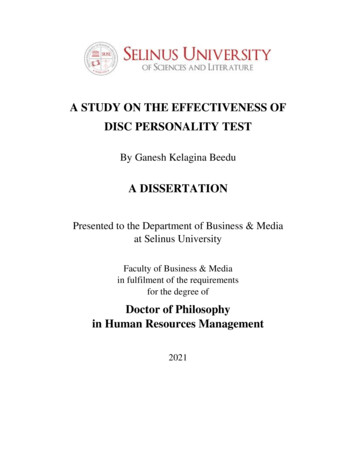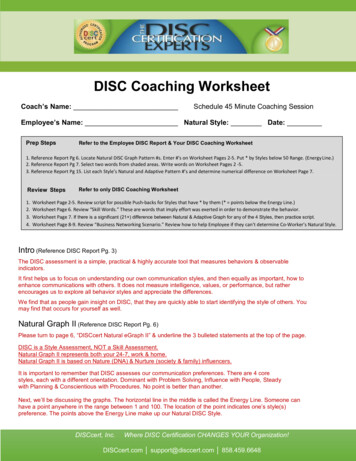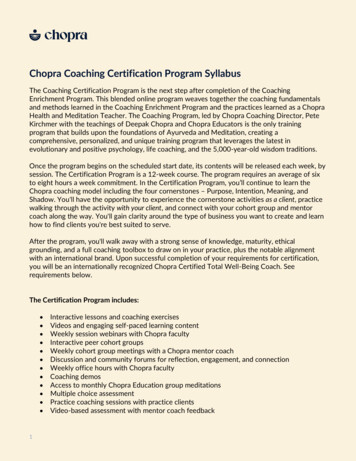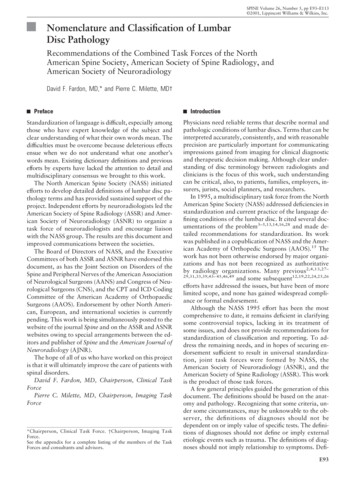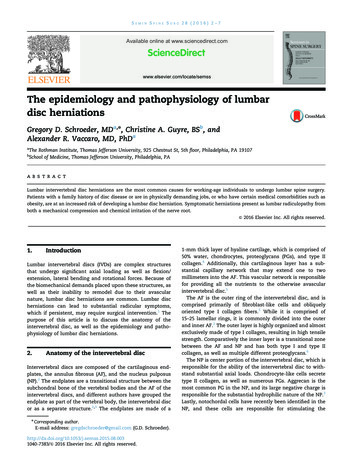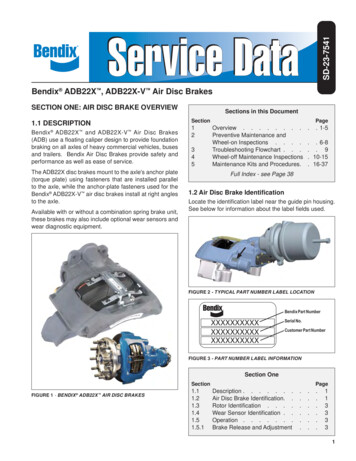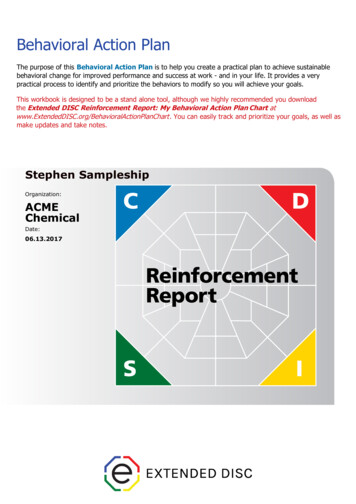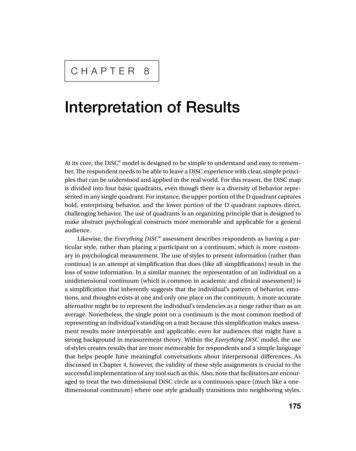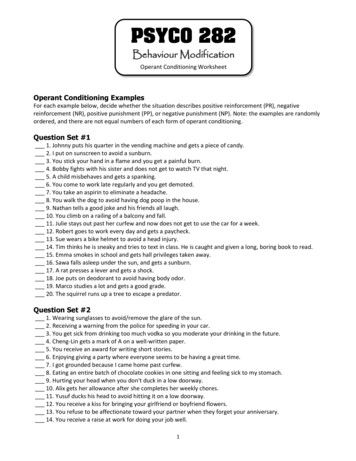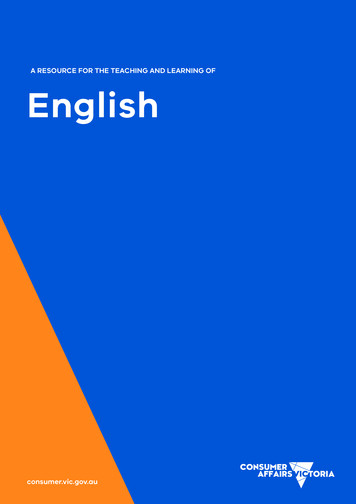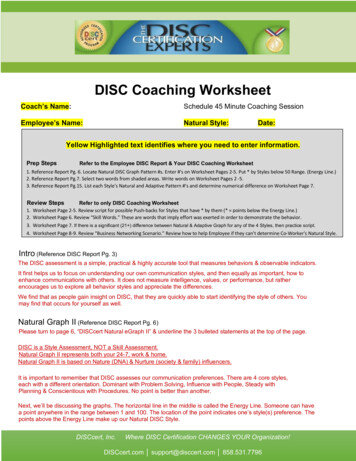
Transcription
DISC Coaching WorksheetCoach’s Name:Schedule 45 Minute Coaching SessionEmployee’s Name:Natural Style:Date:Yellow Highlighted text identifies where you need to enter information.Prep StepsRefer to the Employee DISC Report & Your DISC Coaching Worksheet1. Reference Report Pg. 6. Locate Natural DISC Graph Pattern #s. Enter #'s on Worksheet Pages 2-5. Put * by Styles below 50 Range. (Energy Line.)2. Reference Report Pg.7. Select two words from shaded areas. Write words on Worksheet Pages 2 -5.3. Reference Report Pg.15. List each Style’s Natural and Adaptive Pattern #’s and determine numerical difference on Worksheet Page 7.Review Steps1.2.3.4.Refer to only DISC Coaching WorksheetWorksheet Page 2-5. Review script for possible Push-backs for Styles that have * by them (* points below the Energy Line.)Worksheet Page 6. Review “Skill Words.” These are words that imply effort was exerted in order to demonstrate the behavior.Worksheet Page 7. If there is a significant (21 ) difference between Natural & Adaptive Graph for any of the 4 Styles, then practice script.Worksheet Page 8-9. Review “Business Networking Scenario.” Review how to help Employee if they can't determine Co-Worker's Natural Style.Intro (Reference DISC Report Pg. 3)The DISC assessment is a simple, practical & highly accurate tool that measures behaviors & observable indicators.It first helps us to focus on understanding our own communication styles, and then equally as important, how toenhance communications with others. It does not measure intelligence, values, or performance, but ratherencourages us to explore all behavior styles and appreciate the differences.We find that as people gain insight on DISC, that they are quickly able to start identifying the style of others. Youmay find that occurs for yourself as well.Natural Graph II (Reference DISC Report Pg. 6)Please turn to page 6, “DISCcert Natural eGraph II” & underline the 3 bulleted statements at the top of the page.DISC is a Style Assessment, NOT a Skill Assessment.Natural Graph II represents both your 24-7, work & home.Natural Graph II is based on Nature (DNA) & Nurture (society & family) influencers.It is important to remember that DISC assesses our communication preferences. There are 4 core styles,each with a different orientation. Dominant with Problem Solving, Influence with People, Steady withPlanning & Conscientious with Procedures. No point is better than another.Next, we’ll be discussing the graphs. The horizontal line in the middle is called the Energy Line. Someone can havea point anywhere in the range between 1 and 100. The location of the point indicates one’s style(s) preference. Thepoints above the Energy Line make up our Natural DISC Style.DISCcert, Inc.Where DISC Certification CHANGES YOUR Organization!DISCcert.com support@disccert.com 858.531.7796
We’ll Start with the D – Dominant StyleSomeone with a high “D”Someone with a low “D”Someone with their “D”is energized by solving problems quickly.prefers caution when it comes to problem solving.near the Energy Line likes to solve problems but takes calculated risks.Your “D” is atIt appears you’re more apt to besolving. Does that sound like you?andwhen you are problemIf “Yes,” let employee discuss or move onto next DISC Style explanation.If “No”, ask question below“No” Example: “I am quick at problem solving!”May I ask you a question? If you could have your preference when solving a problem, would you rathergather information or just decide?(99%, the response will be “gather information.”)That makes a lot of sense, because your “D” is below the Energy Line indicating a preference forgathering information. It sounds like you can solve problems quickly if needed, which infers you havedeveloped the skill to solve problems quickly.Remember The DISC Assessment assesses styles & preferences not skills or performance.*(NOTE: If employee is emphatic that the DISC Report descriptions are completely wrong then proceed.)May I ask you a question?(Pause)Would you be willing to run this by a colleague who knows you well & see what they say? (Pause)And, if the other person agrees with you, then just scratch it out. However, your colleague may say theyagree with the DISC Report.(Pause)It’s helpful to remember, we all have blind-spots. And bottom-line the DISC is not intended to tell youthis IS who you are, but, food for thought.DISCcert.com Bonnie@disccert.com 858.531.77962
Next is the I – Influence StyleSomeone with a high “I”Someone with a low “I”Someone with their “I”is energized by expressing their ideas with people.prefers to be understated amongst others.near the Energy Line wants to express their opinion but do it in a poisedmanner.Your “I” is atIt appears you’re more apt to bepeople. Does that sound like you?andwhen you are interacting withIf “Yes,” move onto next style explanation.If “No”, ask question below“No” Example: “I present my ideas very well toothers.”May I ask you a question? Would you prefer to present to a large group or to someone in a one on onemeeting?(99%, the response will be “one on one.”)That makes a lot of sense, because your “I” is below the Energy Line indicating a preference for a moremoderate approach when influencing others. It sounds like you can present to others, which infersyou have developed the skill of presenting.Remember The DISC Assessment assesses styles & preferences not skills or performance.*(NOTE: If employee is emphatic that the DISC Report descriptions are completely wrong then proceed.)May I ask you a question?(Pause)Would you be willing to run this by a colleague who knows you well & see what they say? (Pause)And, if the other person agrees with you, then just scratch it out. However, your colleague may say theyagree with the DISC Report.(Pause)It’s helpful to remember, we all have blind-spots. And bottom-line the DISC is not intended to tell youthis IS who you are, but, food for thought.DISCcert.com Bonnie@disccert.com 858.531.77963
Now we have the S – Steady StyleSomeone with a high “S”Someone with a low “S”Someone with their “S”is energized by working with methodical plans.prefers to be more unstructured.near the Energy Line is fine with some planning and changes occurring.Your “S” is aIt appears you’re more apt to beplanning. Does that sound like you?andwhen you areIf “Yes,” move onto next style explanation.If “No”, ask question below.“No” Example: “I’m very organized!”May I ask you a question? Would you rather spend your time on structuring plans, managing timelines orworking with a variety of projects at all different development levels?(99%, the response will be “variety of projects.”)That makes a lot of sense, because your “S” is below the Energy Line indicating a preference for a morespontaneous approach when planning. It sounds like you can organize a plan if needed, which infersyou have developed the skill to be organized.Remember The DISC Assessment assesses styles & preferences not skills or performance.*(NOTE: If employee is emphatic that the DISC Report descriptions are completely wrong then proceed.)May I ask you a question?(Pause)Would you be willing to run this by a colleague who knows you well & see what they say?(Pause)And, if the other person agrees with you, then just scratch it out. However, your colleague may say theyagree with the DISC Report.(Pause)It’s helpful to remember, we all have blind-spots. And bottom-line the DISC is not intended to tell youthis IS who you are, but, food for thought.DISCcert.com Bonnie@disccert.com 858.531.77964
The 4th Style is the C – Conscientious StyleSomeone with a high “C”Someone with a low “C”Someone with their “C”is energized by following procedures.prefers to experiment.near the Energy Line is fine with using needed procedures.Your “C” is atIt appears you’re more apt to bewith procedures. Does that sound like you?andwhen you are dealingIf “Yes,” move onto next style explanation.If “No”, ask question below“No” Example: “My paperwork is always done correctly.”May I ask you a question? If you could have an expert come in and do your paperwork, would you letthem or would you still want to do it yourself?(99%, the response will be “Let the expert do it.”)That makes a lot of sense, because your “C” is below the Energy Line indicating you would prefer tospend more time on exploring options than on details. It sounds like you can be successful with yourpaperwork, which infers you have developed the skill to work with procedures.Remember The DISC Assessment assesses styles & preferences not skills or performance.*(NOTE: If employee is emphatic that the DISC Report descriptions are completely wrong then proceed.)May I ask you a question?(Pause)Would you be willing to run this by a colleague who knows you well & see what they say?(Pause)And, if the other person agrees with you, then just scratch it out. However, your colleague may say theyagree with the DISC Report.(Pause)It’s helpful to remember, we all have blind-spots. And bottom-line the DISC is not intended to tell youthis IS who you are, but, food for thought.DISCcert.com Bonnie@disccert.com 858.531.77965
Create your DISC Summary (Reference DISC Report Pg. 8)Please turn to page 8, “Create Your DISCcert Summary.”Did the DISC Report’s descriptions sound like you?If response is “Yes” then proceed.Would you share with me what you wrote & why? Let’s first start with your Strengths, Motivators, Potential Areasfor Development & Communication Tips. (Your job will be to listen & acknowledge.)If response is “No” then proceed.May I ask you a question? (Pause)Would you specifically show me the areas that do not sound like you & explain why?(Your job is to listen for “Skill Words.” These are phrases that indicate that the employee used effortto develop a skill. While this is to be commended, the Report is not referring to skills, but ratherbehavior Styles.)Examples of Skill Words“I used to be that way.”“I’m not like that anymore.”“I’ve developed that ability now.”“I’m okay with doing it now.”Pushback Example: “It implies I have time management issues. I don’t have any problems with timemanagement anymore.”Sounds like you have made a conscious effort in developing your time management skills. Is thatcorrect? (Pause)That is to be commended. But the fact that you used effort & developed time management abilitiessuggests skill orientation rather than style. Remember, the DISC Assessment assesses style &preference, not skills or performance. *Now, let’s return to your page 8 & please share with me what you wrote & why? Let’s first startwith your Strengths, Motivators, Potential Areas for Development & Communication Tips. (Yourjob will be to listen & acknowledge.)*(NOTE: If employee is emphatic that the DISC Report descriptions are completely wrong then proceed.)May I ask you a question? (Pause)Would you be willing to run this by a colleague who knows you well & see what they say? (Pause)And, if the other person agrees with you, then just scratch it out. However, your colleague may say theyagree with the DISC Report. (Pause)It’s helpful to remember, we all have blind-spots. And bottom-line the DISC is not intended to tell youthis IS who you are, but, food for thought.DISCcert.com Bonnie@disccert.com 858.531.77966
What are Your Natural & Adaptive Graphs Telling You?(Reference DISC Report pg. 15)Please turn to page 15, “DISCcert eGraphs”As we have discussed, the Natural Graph II represents our 24-7, work & home environments. Nowwe are going to add the Adaptive Graph. It represents how you needed to work to get the job donethe actual day you took the DISC Assessment. It can also represent a longer period of time.Your Adaptive Graph is influenced.by the role you played, who you related to and what responsibilitiesyou performed on the day you took the Assessment. As a result, the Adaptive Graph can change fromday to day, based on your need to stretch out of your comfort zone.In your report, your Natural Graph is used as the benchmark. We add your Adaptive Graph tohelp us to determine if you needed to stretch that day or not. You may have needed to increase ordecrease certain behaviors out of your comfort zone.Your D isin your Natural Graph andin your Adaptive Graph. Difference isYour I isin your Natural Graph andin your Adaptive Graph. Difference isYour S isin your Natural Graph andin your Adaptive Graph. Difference isYour C isin your Natural Graph andin your Adaptive Graph. Difference isRangeYour Response Options.0 – 10Your 2 graphs are similar and you were in your comfort zone.11 – 20Your 2 graphs are moderately different, showing some stretch.21 Your 2 graphs represent a significant stretch.May I ask you a few questions?Most of us do run into situations where stretching is needed. May be result of different responsibilities orrole we take on or how we chose to relate to someone. As you think about last couple of weeks, do anysituations come to mind that required stretching? Please describe.Is stretch just needed Occasionally or is it required Daily?Occasionally Since the stretch is just occasionally, it does not require intense, on-going effort.Knowing and accepting this ebb and flow of adapting is perspective that reduces stress andincreases ability to manage change.Daily When people have a significant stretch that is required daily, it’s important they address andexplore what are some creative solutions. Have you had an opportunity to start considering somestrategies that could be extremely beneficial?DISCcert.com Bonnie@disccert.com 858.531.77967
Action Plan for All Four Styles (Reference DISC Report Pg. 29)Please turn to page 29, “Action Plan for All Four Styles.”It’s time to now apply what you have learned. Please identify a co-worker (or internalcustomer) that you interact with frequently. Now determine their DISC Style by firstconsidering if their pace is quick or deliberate. Then reflect on your conversations with them.is their priority on people or tasks?(Pause)Do you have a good sense of what you think their Natural DISC Style is?If response is “yes” then proceed with reading the following instructions.1.Add a !by Characteristics that match your co-worker2.Add an Xby (Communication) “Tips for Others” you currently use with your selected co-worker.3.Insert aaround the remaining “Tips for Others.” You now have your overall Action Plan4.Add aby one of the “Tips for Others” you will first apply.If response is “No” then proceed with scenario below.Picture your co-worker entering a BusinessNetwork Event.Which of the following is your co-worker more apt to do?Walks into the event, pass out 50 business cards & leaves.Then their style would be .High D StyleHigh I StyleTalks with as many people as they can & will introduce themselves to anyone they don’t know.Then.Walk in, pause, look for someone they know & talk with that person the whole event.Then.High S StyleReluctantly walks in, stands still waiting for someone to talk to them. Will leave after 5 minutes.Then.High C StyleDo you have a better sense of what your co-worker’s style may be?Now, that your co-worker’s style is determined,I’ll walk you through the rest of the steps on your page 29.DISCcert.com Bonnie@disccert.com 858.531.77968
Action Plan for All Four Styles (Continued)1.Add a !by Characteristics that match your co-worker2.Add an Xby (Communication) “Tips for Others” you currently use with your selected co-worker.3.Insert aaround the remaining “Tips for Others.” You now have your overall Action Plan4.Add aby one of the “Tips for Others” you will first apply.At bottom of your Page 29, “Your Action Plan:” please expand on how you will incorporate the “starred”behavior you identified above.Please do this by listing your co-worker’s name, a discussion topic & when you might meet with themnext. List the behavior you put a star next to & describe how you would incorporate that into yournext interaction with them.Here’s an example. My co-worker’s name is Jane & I’ve identified her as a “D” & put a star by“Anticipate Questions.”My write-up would say: I’ll be meeting with Jane next Tuesday to discuss the first quarter budget. I willspend time thinking in advance what questions she will have of me. I know she’ll definitely be asking mehow we are comparing so far with last year’s budget.In Summary We’ve explored how your DISC Styles work and now end with an Action Plan to setyou up for optimum communication success. You’ll find you’ll be using DISC at home as well. Infact, it is available to you to use in all your interactions with others, your peers, boss, internal &external customers.Much continued success to you!DISCcert.com Bonnie@disccert.com 858.531.77969
DISC is a Style Assessment, NOT a Skill Assessment. Natural Graph II represents both your 24 -7, work & home. Natural Graph II is based on Nature (DNA) & Nurture (society & family) influencers. It is important to remember that DISC assesses our communication preferences. There are 4 core styles, each with a different orientation.

